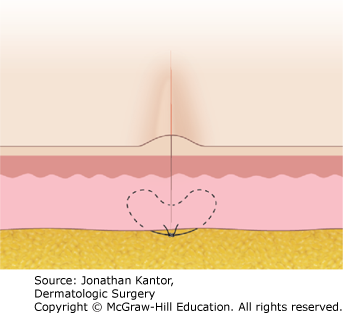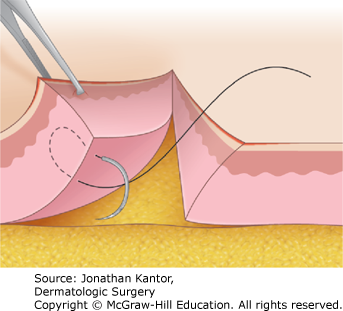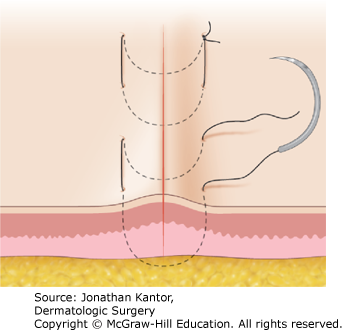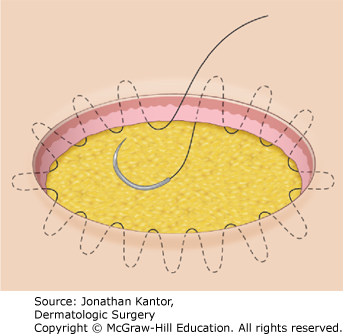Dermatology Question of the Week: Surgical Skills

Question:
Which of the following suturing techniques is most useful for hemostatic purposes?
Answers:
A. 
B. 
C. 
D. 
E. 
Rationale:
A plethora of deep and superficial suturing methods exist. Understanding the positioning and purpose of particular suturing techniques is a commonly tested surgical topic and helpful clinically in determining closure technique.
Correct answer: D Horizontal mattress suture
Horizontal mattress sutures are useful for hemostasis in addition to eversion. A horizontal mattress is similar to a foxtrot dance foot movement. The needle enters from the epidermis adjacent to the wound edge and exits from the contralateral side. The surgeon then moves horizontally and reenters the epidermis on the same side exiting the wound on the side of the original needle entry point; the two suture ends are now on the same side (original needle entry point) located parallel to the wound edge and are tied together. One downside is that overconstriction of epidermal tissue may increase the risk of tissue ischemia/necrosis.
Incorrect answers:
A. Buried vertical mattress. Performed by inserting the needle at 90 degrees on the underside of the dermis, approaching the epidermis, and coming out at the reticular dermal edge. Then the needle is inserted into the opposing reticular dermal edge and the needle is rotated so that it approaches the epidermis before curving and coming down outside of the underside of the dermis. The knot is tied underneath the skin and the heart shape produced leads to good eversion and approximation.
B. Set back suture. Performed by inserting the needle on the underside of the dermis and rotating so that the exit point is also on the underside of the dermis on the ipsilateral side. The needle is then grasped and inserted onto the underside of the contralateral dermis and rotated to exit on the same underside. This is an excellent suture for tension relief and aids in wound eversion.
C. Vertical mattress suture. Performed by inserting the needle widely from one epidermal surface on one side of the wound exiting widely on the epidermis of the contralateral side. Then the needle is inserted back through the epidermis closer to the linear wound and exits on the original entry point side closer to the incision. The two ends of the suture are now on the same side (the side you started on) and are tied together. This is used frequently for wound closure and helps with wound eversion.
E. Buried purse string closure. Purse string closure involves the placement of one continuous suture along a circular defect tied with one final knot which cinches the circular defect into either a smaller circular defect or completely closes the defect. This can be useful when avoiding linear closure or attempting to create a smaller wound opening than secondary intent healing.
Additional reading at Dermatologic Surgery Chapter 13: Suturing Techniques

Create a Free MyAccess Profile
AccessMedicine Network is the place to keep up on new releases for the Access products, get short form didactic content, read up on practice impacting highlights, and watch video featuring authors of your favorite books in medicine. Create a MyAccess profile and follow our contributors to stay informed via email updates.